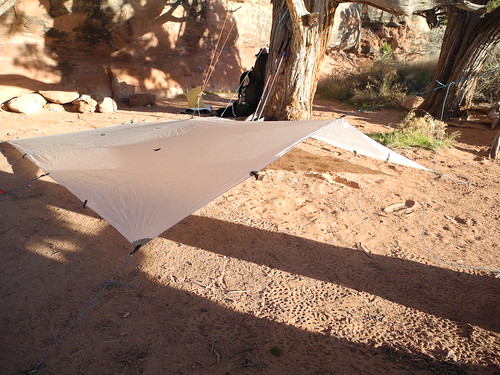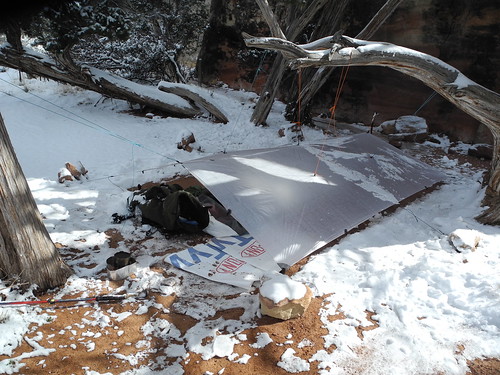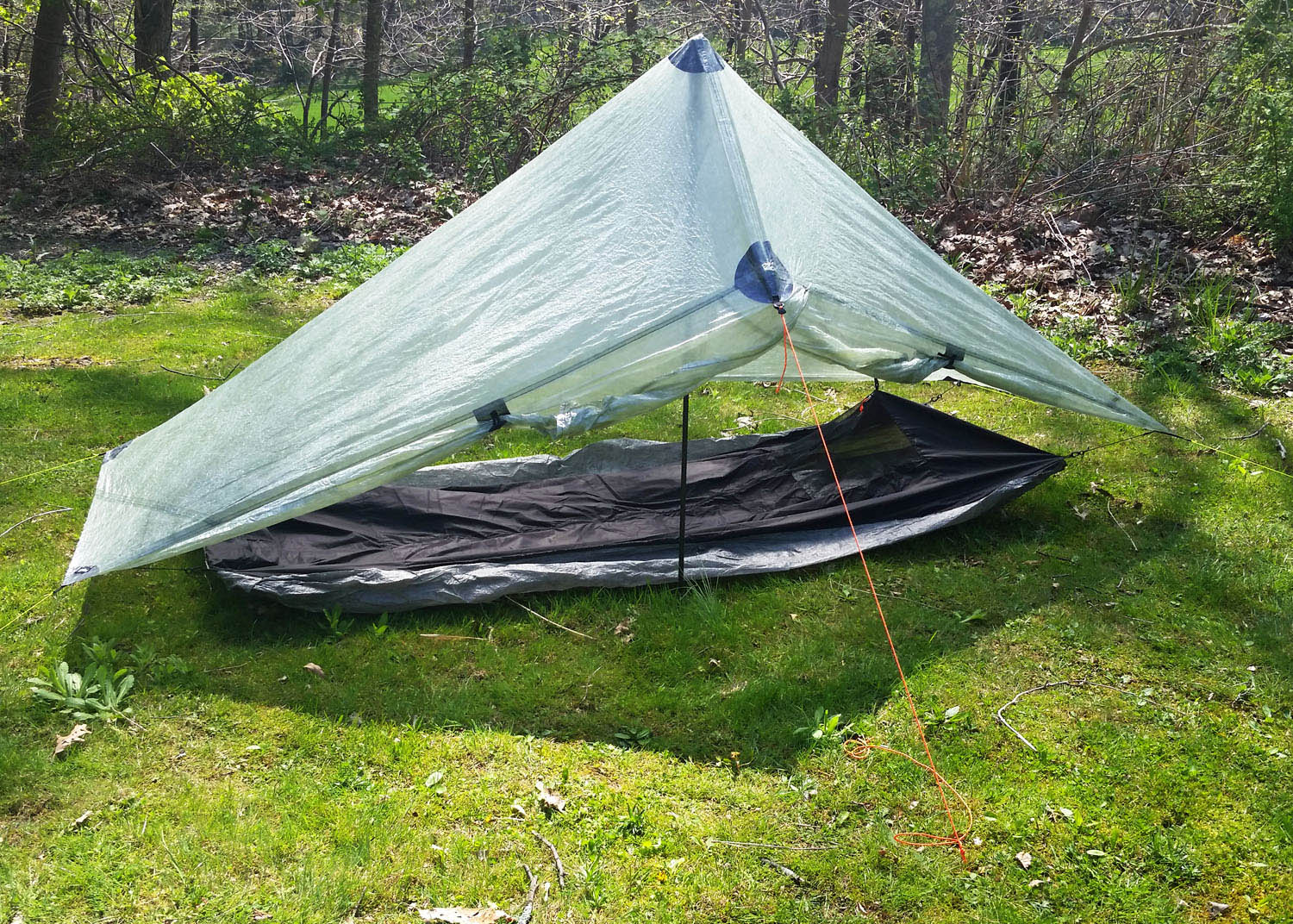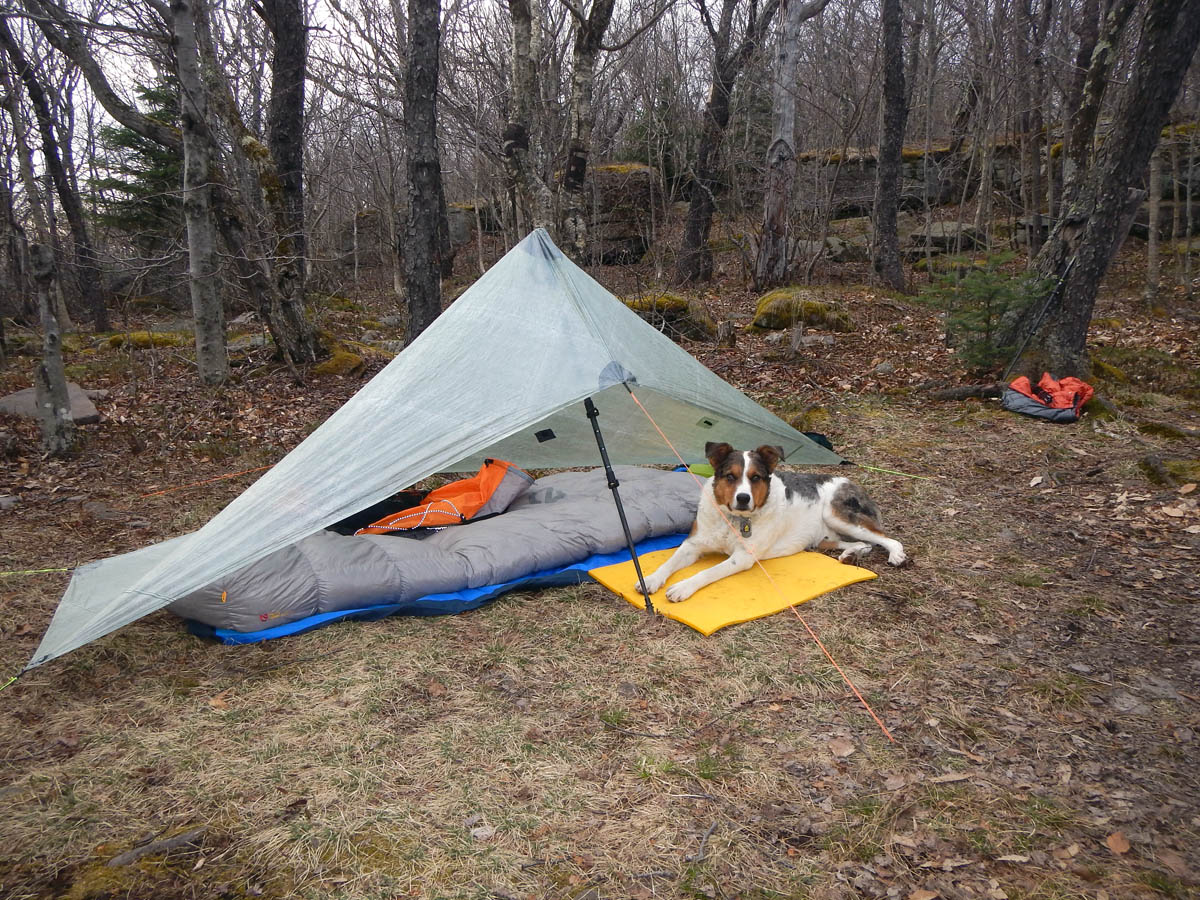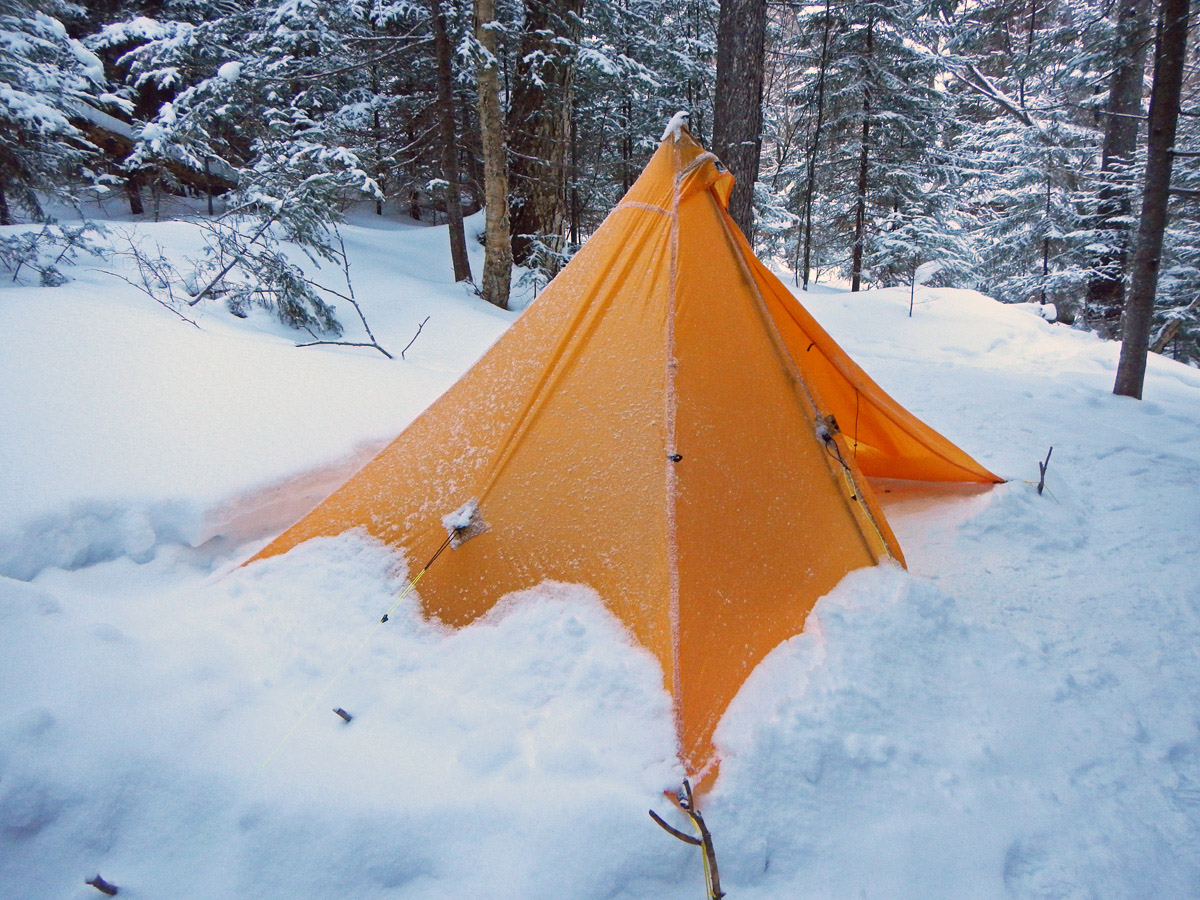Topic
Tarp above the trees (flat vs hex vs ?)
Forum Posting
A Membership is required to post in the forums. Login or become a member to post in the member forums!
Home › Forums › Gear Forums › Gear (General) › Tarp above the trees (flat vs hex vs ?)
- This topic has 75 replies, 16 voices, and was last updated 6 years, 6 months ago by
 Eric Blumensaadt.
Eric Blumensaadt.
-
AuthorPosts
-
Sep 6, 2017 at 6:49 am #3489306
Howdy,
I have a 2p DW sil cirriform. I mostly hike solo however and want to lighten my solo load significantly. I have some zpacks vouchers so I was considering a zpacks flat tarp (like 9×7) or a hexamid. I dont already own a bivvy, so I might go for the full hex tent with polycro if I decided it would work for me, since the cost would be a wash with a bivvy and much more livable. Also vaguely considering the pocket tarp, but I think if zpacks cleaely call it an emergency shelter I’m a little concerned about durability.
I could also use my zpacks vouchers elsewhere and consider a cricket (best cost and weight) solomid (probably the most bomb proof) or custom mini trailstar (in effort to lower footprint and weight, and be very close to bombproof – though I hear it could be a difficult in cuben?). I’d pair any of these options with a bivvy (custom borah bug bivvy with capped ends, or one of the new offerings from mld and ee)
My needs:
-storm proof is the most important as I love to camp above the trees, and in new Zealand the weather changes very fast.
-small footprint is nice. Often I am in places where viable campsites are difficult to find. Solo I don’t care so much about livable space as I find I don’t hang out much at camp. Space is a nice bonus but my least important need.
-cuben (want to go as light as possible and I have found sag on my sil cirriform a bit annoying)
-some notion of openness, I hate feeling closed off from my surroundings in my cirriform.
So any advice? If it is possible to become skilled enough with a flat tarp to make it a viable shelter when the weather is blowing rain sideways? If so it ticks all my boxes with the least investment. If not what of my other options demand serious consideration?
I suspect of the non flat options, the hex is the least storm stable?
Sep 6, 2017 at 8:06 am #3489318Disclaimer: I’m not an old-timer with 40 years of backpacking experience. I suspect you may get responses from people that have more experience than myself. That said, I think you are thinking about this pretty clearly.
I really wanted to like a flat tarp. I spent some time with an 8.5′ x 8.5′ including one very windy night and found the fiddle factor to be way too high. I can achieve a good pitch with it but it requires way too much line and too many stakes/rocks, all of which take time. In the end you don’t have much headroom if you are in storm mode. I don’t spend a lot of time in camp either but it’s nice to be able to pull your pants on in the morning without rubbing up against the tarp.
I’ve been in two heavy thunderstorms in a ZPacks .51 Duplex above treeline in the Sierra with tons of water and impressive wind gusts. The tent provides good protection, pitches easily and is livable. Based on that experience, I wonder if you might want to consider a .74 Solplex?
I don’t use a Solplex because I have discovered that I like sleeping in a bivy without a tarp. I like bug protection (scorpions in AZ, mosquitos in the Sierra) but I like sleeping outside without a tarp and I like the simplicity of camp setup/breakdown with a bivy.
I’ve moved on to a silnylon Duomid for protection rather than my flat tarp. It pitches so quickly compared to the flat tarp, provides 360° protection, doesn’t require ridiculous amounts of line and needs fewer stakes/rocks. It’s not the lightest option but I’m currently doing most trips with my teenage son and he’s becoming extremely strong so he takes the Duomid. (This is a great approach to UL backpacking, btw. Have your son carry some of the heavier stuff!)
As the boy gets older and eventually decides that he doesn’t want to keep backpacking with dad I’ll downgrade to a 1P solution. I suspect that will either be a Hexamid Tarp in .74 or a Solomid.
Two solutions I have not tried but am tempted by are the cuben Patrol and Cricket. I do not enjoy front entry tents and I don’t think the Cricket makes sense in the swirling, multi-directional storms I have experienced in the Sierra. Furthermore the cuben Cricket is not supposed to pitch low very well. If I try one of these two options it would likely be the Patrol unless I transition to being below treeline in the woods more in which case the Cricket looks more attractive.
I hope that helps.
Sep 6, 2017 at 4:15 pm #3489433Yeah fair point. In theory I like the nerdiness of the fiddle factor.. In practice maybe not so much, especially when it really matters (bad weather). If I decide a flat tarp offers sufficient protection I will try a cheap option before going in on cuben to see if the fiddle factor is something I am OK with.
I think I prefer the hex over the solplex for the same reasons as you (versatility and cowboy camping). What are your feelings between the solomid and hex? Also curious as to why you’d change to solomid from a duomid, given the marginal weight difference? Smaller footprint is nice of course.
For the weight / cost difference between the solomid and duomid its tempting to sell the cirriform and use the duomid for everything.. Larger footprint being the only obvious negative, and maybe too tight for two (I’ve found liveable space much more important with my partner than solo). Conundrum. Probably still too heavy overall.
If I have a child now, i guess by the time I can afford a duplex the child should be old enough to be a pack mule..
I really like the design of the cirriform, which is similar to the patrol. Arguable a better design/better features (but heavier if I remember correctly). I’m not sure how the storm worthiness compares to the cricket. I suspect the big flat sides of the patrol make it problematic in swirly winds (as does the open part of the cricket). Do I’m not too sure what advantages the patrol offers actually? Smaller footprint perhaps (on my phone so a pain to properly check)
Sep 6, 2017 at 6:44 pm #3489479re: Cirriform vs. Patrol… I forgot what the Cirriform was and didn’t look it up until after i posted. It does seem very similar to the Patrol. I like how the Patrol pitches but I haven’t used either in the field so I don’t really know.
re: Fiddle factor… I like fiddling with a flat tarp when I’m car camping with the family. It gives me something to do around camp. But not backpacking.
re: Solomid vs. Duomid… My bilnylon Duomid pushes the limit of what I want to carry on a solo trip depending on miles and difficulty. I’m not running out to buy a Solomid any time soon. It’s a small benefit but I’d prefer something that packs smaller and lighter.
One last thought… $300 for a Hexamid tarp seems like such a deal. And if you have a voucher for ZPacks then you should jump on one of those. I would, in .74…
Sep 6, 2017 at 9:58 pm #3489550I’ve almost exclusively used a flat tarp (HMG 8×10) in the Sierra and now in the Southwest. I’m not an expert in tarping by any means, and maybe have three years total exclusively using a flat tarp, but find it easily one of the most enjoyable shelters I’ve ever used. By enjoyable I mostly mean the versatility: on my last two trips I got caught in some epic hail storms in the Weminuche and on the CDT near the Knife’s Edge – I was able to pitch the tarp in between a few trees and wait out the rain and hail in comfort. The areas available to pitch the tarp wouldn’t have been possible with anything other than a flat tarp or cat cut tarp.
Limitations are easily observable with a flat tarp and you have to be willing to make sacrifices. One of those is camping above tree line if any kind of severe weather is coming in – not gonna happen in a flat tarp. For the most part, I camp in the trees and the fiddle factor of the tarp is significantly decreased by anchoring the ridge line to a tree. I carry two trekking poles but generally only use one to set up the tarp, making pitching a hell of a lot easier.
I too find fiddling with a tarp enjoyable, but I do so in the relative safety and comfort of tree line. I have a solomid XL but I find myself not bringing it very often.
Sep 6, 2017 at 11:56 pm #3489575That makes sense to me. Handing the tarp off trees gives a stable platform to pitch and the 8×10 size gives much more room for finding a dry spot.
I’m not willing to commit to trees all of the time (although usually I am in or near trees).
Trees mean even more line though…
Sep 7, 2017 at 12:09 am #3489576Yeah OK so the limitations of a flat tarp are probably what I expected (but hoped against), so its out of the equation until a time I can afford to have more than one or two shelters..(spent many trips not going below the trees for 2-3 days).
So it really boils down to if the hex is going to be storm worthy enough. Because as you say Matthew, at that price (minus some vouchers) its a pretty good deal. In saying that if I didn’t have vouchers I’d probably be going for one of mlds mids for the perceived bombproofness at the cost of the footprint space. So its a question of how much real world difference the hex tarps inferior storm performance is going to ever be a factor.. Hm
Sep 7, 2017 at 4:43 am #3489590I usa aa shaped tarp almost exclusively for solo hiking. A simple little tarp that sets up easily with my trekking pole, yet covers about 4×8 of ground completely dry. It will cover the old GoLite net tent I sometimes use in hotter weather to avoid bugs. I have 9 stakes for it, but in the middle of summer I usually only need 5. The others are for winds and stormy weather. I have ridden out 40-50mph wind & thunderstorms and heavy rain that raised the creek over two feet overnight. I was dry…I worried more about the soggy trail conditions (slippery mud & rocks, creek crossings, mud puddles and cold, wet scrub.) Like the Cirriform, it is a little heavy for three season trips, but only requires about a 10×14 area to set everything up. It’s total weight is around 17oz including guylines and stakes.
Sep 7, 2017 at 8:19 am #3489616Not to hijack the thread, but I don’t see the issue above treeline(in theory) of a 9×7 tarp. You can pitch it really low so that the wall angle is the same as a Trailstar, and you can close both ends(at least that’s what geometry tells me).
Sep 7, 2017 at 10:41 am #3489653You’re not hiijacking the thread john, these alternative perspectives are invaluable! Yeah I think the geometry works (would need to some tests with a cheap first to see if its ok to live under in such a configuration. But itd be nice to get some perspective from people who always use a flat tarp (like james has).
James how hard do you find setting up your tarp in strong wind? Do you have a flat tarp or is it a cat cut a frame? I gather you use it only as an a frame either way. My understanding was that there are more storm worthy pitches with a flat tarp, but that an a frame was popular for being easy for how much protection it offers.
Sep 7, 2017 at 10:47 am #3489654I don’t see the issue above treeline(in theory) of a 9×7 tarp
It all comes down to site selection and anchor strength. Several years ago we did an up-and-over climb of Mt. Rainier from the West side (long approach) and descended the South side with a large flat silnylon tarp with no problems. Pretty sure it was 10×10 and there were three of us. We had bivy sacks too, which kept us dry enough at the edges of the tarp.
At treeline we spent two nights waiting out rain before we could get up on the mountain. Also camped two nights at 10’000 on the glaciers, where we pitched the tarp very low and dug a shallow recessed platform to sleep on. Anchors were poles or buried stuff sacks in snow (very strong). While we had no storms while up on the mountain, this setup did fine with some good breezes.
Sep 7, 2017 at 5:03 pm #3489744John,
I wouldn’t go above tree line with anything less than an 8×10 flat tarp. Pitching the tarp low significantly reduces the amount of livable space under the tarp. If it’s raining you don’t want your sleeping bag rubbing up against the underside of the tarp, or getting splashed on. I’ve weathered some very windy nights both above tree line and in the trees, the 8×10 has handled the wind, rain, and snow better than I could have hoped for. But still, if I know there is a chance of rain or significant wind, I wont chance being above tree line in a flat tarp. And you can damn near shut one side of a flat tarp, but shutting both sides while maintaining a livable space inside doesn’t seem feasible to me. I tend to hike all day and I’m happy to have a safe campsite at night rather than risk a night filled with worry that my tarp will be blown away or my sleeping bag will get drenched.
Sep 7, 2017 at 8:20 pm #3489786Dylan, I was actually looking into making a tarp for above treeline. I had settled on a 7×11 to increase living space. Would more tie outs alleviate your concerns? Being that I’ve never used a tarp, any advice you would have would be great.
Sep 7, 2017 at 10:12 pm #3489799The HMG 8×10 has more tie outs than I know what to do with – that’s not my concern about tarping above tree line. My camping is mostly done in Colorado, late June-October. In June and early July I feel much better camping above tree line because monsoon season hasn’t started. As soon as monsoon season starts and the threat of lightning and buckets of rain come into the mix, I’m back in the trees. Come September and October I’ll flirt with camping above tree line, but it starts getting too cold and I seriously start considering bring a mid.
These pictures are from Utah, but gets a point across about tarps. This was one of the windiest nights I’ve ever experienced, where the wind didn’t die down until 2am. After 2, about 3 inches of snow fell.
I had to get up in the middle of the night and put a trekking pole in the rear of the tarp to increase snow shedding, but other than that I survived the night. Hard to tell from the picture, but there is not a lot of room under there. I had protection of a rock wall in the back and a couple of trees – if I was out in the open I doubt I would have had such a comfortable night. Also, note the plethora of guylines.
It really comes down to the wind and rain up above tree line, and the fact that while a nice above tree line campsite and sunrise is nice, not having to chase after my expensive tarp in the middle of the night, and piece of mind is better for me. I think playing around with a 7×11 would be fun – just make sure you have plenty of guy outs and mid panel tie outs.
Sep 7, 2017 at 10:57 pm #3489811Check out the hammock tarps for 11′ ridgeline (John E…maybe you knew that). Some also have doors, which may make it more storm worthy and drier than rectangular tarps pitched as an A-frame. Warbonnet has 2 new models that have partial doors, which could be pitched like a larger patrol tarp. Many have cat cut sides, but there are some that are flat. I would have two concerns using these above treeline: (1) too large for some locations, and somewhat related (2) I can only imagine it pitched as an A-frame so maybe too large? The hammock tarps don’t have all the tie out points per side in most cases, and I don’t think they have the underside attachment points to lift your bivy netting off of you. If you are making your own you can remedy those last two limitations.
I’ve been following along because I am always looking for a tarp that I can use with a hammock and on the ground if necessary (presumably above treeline. I picked up a Yama 9×9 here on BPL, but haven’t tried it yet. I tried pitching an 8×10 old campmor tarp in the yard, but found most pitches to be wasteful, i.e. there was a lot of unusable space. I give kudos to Dylan for his minimalist pitches above, but for me, I really want to sit up, and hopefully avoid touching the tarp too often with my quilt or body.
Matthew convinced me previously that I should decide in advance if I’m hammock camping or ground camping – and I think he’s right, but since I too have a teenage porter, we’re planning to take a DuoMidXL, which my son will carry along with an inner or bivy on our next Sierra trek. I’ll still take a hammock and the the Yama or a minimalist Asym tarp. It’s overkill I know, but we can hunker down in the DuoMid above treeline if necessary and can sleep in comfort under the stars if I find trees.
If it were just me, and starting over, I’d consider the hexamid or something like it and a bivy or bug bivy. Or if I was smart, I would stop investing in all these other shelters and get a Duplex.
Sep 8, 2017 at 12:13 am #3489823Thanks for the feedback on the 8*10 size. One consideration I have is to eventually pick up a mid when I expect more troublesome weather, so I was wanting to push the size down if I went flat tarp for maximum weight, space and footprint size savings.
John, I’d be curious to know how your 7×11 tarp goes. Its not a size I see suggested too often:)
I really need to do a cheap flat tarp prototype to see what size works best for me. Polycro? But I really need to experience it in some bad weather and don’t want to be in polycro under bad weather..
Bob, if I were going for a do it all solution I think a duomid would be my shout :) but the weight creeps up a bit. I think about 5oz more than the hexamid. In the past I haven’t been able to financially justify two shelters at 5oz weight difference.. Obviously been reading bpl too much (and I have zpacks credit to use!)
Sep 8, 2017 at 4:47 am #3489839Maybe Hexamid Solo plus (the one with ‘storm doors’) in .74 cuben?
I have one in .51 cuben and it hasn’t seen heavy wind — on one occasion 25-30 mph wind all night… laughably tame for a Scot — and only one night with moderate wind (15-20 mph, maybe) and rain and it performed superbly. Could’ve handled a lot more. Pitched fairly low and combined with my splash bivy clone it felt very comfortable and secure. Good shoulder season combo when I don’t have my pooch along.

Maybe also consider a Grace Duo tarp or flat tarp with EE Recon bivy.
Sep 8, 2017 at 4:58 am #3489840I dont think the plus would be worthwhile for me, solo I want to get as light as possible and dont mind sacrificing space. 0.74 is an option I am considering, but zpacks seem very confident in 0.51….
And yeah still considering the flat tarp. I think a recon bivvy (or maybe a custom bear paw) will be my bivvy of choice, seems better for cowboy camping with the footbox compared to the bb2.
Re the grace: if I were to go cat cut at the expense of the versatility of a flat, I’m more interested in a cuben patrol. Or I’m back looking at mids..
Sep 8, 2017 at 5:33 am #3489842I’ve never even seen a Patrol in any version but I’ve read lots of good stuff about it.
The thing I like most about the Hexamids (vs flat/cat tarps) is that I can sit up in them when they are pitched low because the peak is in the middle. It makes doing everything easier, whether changing clothes or cooking, etc. I used a Pocket Tarp (.34 DCF) for a while it was really pretty good for weather as long as the wind didn’t change direction, which is of course the bane of tarping. :^/

I’ve also experimented with a HMG Echo II (similar to Grace Duo) with the clone Zpacks bivy (prototype version in photo below, custom made by a fellow BPLer) and it worked quite well in the rain, although I discovered I prefer 360° coverage when the wind changes direction. Got considerable blowing rain on the high end but I must say the bivy (made with Momentum 90 on the top) handled with with aplomb. Wouldn’t want to make a steady diet of it however.
 Sep 8, 2017 at 5:56 am #3489845
Sep 8, 2017 at 5:56 am #3489845Yeah and I know from my cirriform I’m quite comfortable with the design. Cirriform is fantastic design, but has a lot of details which add weight compared to the patrol. Not superfluous features I should say, really functional and well designed – but I want to get quite minimalist.
Good point about sitting up in the hex. Not crazy important but when you’re soaking wet some space can be nice while faffing about trying to get into something drier etc.
How did you find the 0.34 material? From some brief reading it seems the main risk is putting a stick through it. If the hex design just isn’t suitable above the trees and its a fair weather/forest shelter anyway, it’s tempting to go super light where failure is less likely and just use it in for those said conditions… The price is very attractive too. And then trade the cirriform in for a duomid for more serious solo trips and partner trips.
(But then we are back to the same functionality as a flat tarp with more livable room and less potential versaility. Easy to go in circles huh.)
Sep 8, 2017 at 6:18 am #3489849Yes the .34 is light!! But with good care it could last a long time.
As far as damage from falling branches and stabbing it with trekking poles, I would advise the same as with other gear… be careful where you pitch and $hit happens, lol Definitely not for folks who are hard on gear.
Silnylon Duomid is my winter tent. Not alpine or heavy snow (I’m not into that any more), and IMO it is a good solo mid. I would NOT want to cram 2 people in there (I’m 5’9″ medium build) tho plenty of room for me and dog.
 Sep 8, 2017 at 6:40 am #3489854
Sep 8, 2017 at 6:40 am #3489854Dylan, awesome pictures! The low pitch is definitely a no go for snow. After having that experience, do you think a Solomid would have been any less stressful?
Sep 8, 2017 at 6:44 am #3489855Yeah falling branches can mean much bigger issues than a hole in your shelter… I do have a rough tendency I suspect, but I’m not reckless and I dont think I’m more likely to damage a tent (but my pack takes abuse for example).
Yeah I’ve read the mixed opinion on the duomid for two. I’m a little taller than you but pretty narrow framed (about 58kg at the moment.. But I’ve been hiking a lot in the last month so I’ve lost a few kg!) And my partner is even smaller (45kg or so), so we can make small spaces work. From memory the dimensions of the duomid inner was similar to the cirriform, albeit a different (perhaps less livable?) Shape. Cirriform hasn’t been a big issue but waiting out some bad weather with two people in there was 15 hours of lying down.. Solo I would’ve walked 4-5 hrs in the weather (not storm, just very wet), but space would be more important with two. So perhaps I’d look at the duomid xl for 2p use. Another decision to obsess over but not for now!
Sep 8, 2017 at 11:07 am #3489882One other option that I’ve been personally interested in is a Duplex TARP. Combined with a lightweight bivy, you could have a very versatile shelter for right around a pound. It would give you the ability to cowboy camp, have a very open setup with all doors open, or a very storm-worthy setup with all doors closed and pitched tight to the ground. The Duplex Tent doesn’t really pitch tight to the ground well due to the bathtub floor collapsing somewhat. I have the tent, which is awesome and has served me well in the Sierra above treeline, but part of me wishes I’d tried the tarp with a bivy for the increase in versatility and better ability to pitch it low. Although with all the doors open it is very close to cowboy camping with a bivy in terms of openness. And I’m working on a modification to the bathtub floor that will help it keep its shape when pitched low.
Edit: I’d avoid the Trailstar and Cricket if your preference is Cuben. I think the versatility of both of those shelters is inhibited by the non-stretch nature of Cuben. I had a Cuben Cricket and did enjoy it very much, but I wasn’t able to get the open front low enough to be confident in its ability to keep weather out in the Sierra near treeline.
Edit 2: A couple other advantages of the Duplex tarp: Easier to cook in in bad weather, and you can sleep in the “normal” direction or perpendicular to it with any combination of doors open/closed, which I think would be cool. :)
Sep 8, 2017 at 11:11 am #3489884The Duplex Tarp is a good suggestion imo. Will Reitveld has a good review of this setup here.
-
AuthorPosts
- You must be logged in to reply to this topic.
Forum Posting
A Membership is required to post in the forums. Login or become a member to post in the member forums!
Our Community Posts are Moderated
Backpacking Light community posts are moderated and here to foster helpful and positive discussions about lightweight backpacking. Please be mindful of our values and boundaries and review our Community Guidelines prior to posting.
Get the Newsletter
Gear Research & Discovery Tools
- Browse our curated Gear Shop
- See the latest Gear Deals and Sales
- Our Recommendations
- Search for Gear on Sale with the Gear Finder
- Used Gear Swap
- Member Gear Reviews and BPL Gear Review Articles
- Browse by Gear Type or Brand.

